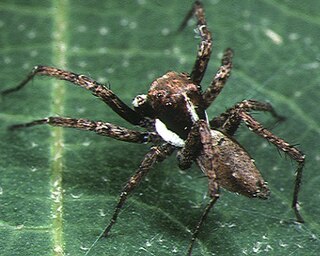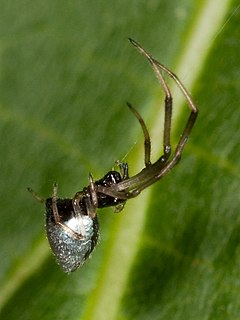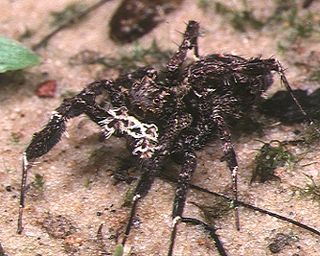
Portia is a genus of jumping spider that feeds on other spiders. They are remarkable for their intelligent hunting behaviour, which suggests that they are capable of learning and problem solving, traits normally attributed to much larger animals.

Myrmarachne is a genus of ant-mimicking jumping spiders that was first described by W. S. MacLeay in 1839. They are commonly called antmimicking spiders, but they are not the only spiders that have this attribute. The name is a combination of Ancient Greek μύρμηξ, meaning "ant", and ἀράχνη, meaning "spider".

Portia labiata is a jumping spider found in Sri Lanka, India, southern China, Burma (Myanmar), Malaysia, Singapore, Java, Sumatra and the Philippines. In this medium-sized jumping spider, the front part is orange-brown and the back part is brownish. The conspicuous main eyes provide vision more acute than a cat's during the day and 10 times more acute than a dragonfly's, and this is essential in P. labiata′s navigation, hunting and mating.

Carrhotus is a genus of jumping spiders that was first described by Tamerlan Thorell in 1891. The name is derived from the Greek Κάῤῥωτος.

Cocalus is a genus of jumping spiders that was first described by Carl Ludwig Koch in 1846, and is named after Cocalus, a Sicilian king of Greek mythology.

Epeus is a genus of the spider family Salticidae. They are often found on broad-leaved plants or shrubs of rain forest, or in gardens of Southeast Asia.

Hyllus is a genus of the spider family Salticidae. Most species occur in Africa and Madagascar, with many in Australasia and north to India. H. insularis is found in Greece and Iran, but it is considered misplaced in this genus, and is now Evarcha insularis.
Macopaeus is a genus of jumping spiders endemic to Madagascar. It contains only one species, Macopaeus spinosus. Two other species were described in this genus in the early 20th century. However, these were transferred to the genus Brettus in 1980.

Phaeacius is a spider genus of the family Salticidae, found in sub-tropical China and between India and the Malay Peninsula, including Sri Lanka, Sumatra and the Philippines. Although other spiders can jump, salticids including Phaeacius have significantly better vision than other spiders, and their main eyes are more acute in daylight than a cat's and 10 times more acute than a dragonfly's. The main eyes focus accurately on an object at distances from approximately 2 centimetres (0.79 in) to infinity, and in practice can see up to about 75 centimetres (30 in). They do not spin webs.

Rhene is a spider genus of the family Salticidae.

Argyrodes, also called dewdrop spiders, is a genus of comb-footed spiders that was first described by Eugène Louis Simon in 1864. They occur worldwide, and are best known for their kleptoparasitism. They can spin their own webs, but tend to invade and reside in their hosts' webs. This relationship can be commensal or even mutual if the dewdrop spider feeds on small trapped insects that are not eaten by the host. Some species can even prey upon the host.

The Spartaeinae are a subfamily of the spider family Salticidae. The subfamily was established by Fred R. Wanless in 1984 to include the groups Boetheae, Cocaleae, Lineae, Codeteae and Cyrbeae, which in turn were defined by Eugène Simon.

Maevia inclemens or the Dimorphic Jumping Spider is a relatively common and colorful jumping spider of North America. In the males there are two forms, a very rare phenomenon in zoology. These use different courting displays, and differ in appearance: the "tufted" morph has a black body and pedipalps ("palps"), three black tufts across its "head", and pale legs; and the "gray" morph has black and white stripes all over its body and legs, orange palps, and no tufts. However, each form accounts for 50% of the adult males, and they are equally successful in mating. A female of Maevia inclemens is 6.5 to 8.0 millimetres long, while males are 4.75 to 6.50 millimetres long.

Portia fimbriata, sometimes called the fringed jumping spider, is a jumping spider found in Australia and Southeast Asia. Adult females have bodies 6.8 to 10.5 millimetres long, while those of adult males are 5.2 to 6.5 millimetres long. Both sexes have a generally dark brown carapace, reddish brown chelicerae ("fangs"), a brown underside, dark brown palps with white hairs, and dark brown abdomens with white spots on the upper side. Both sexes have fine, faint markings and soft fringes of hair, and the legs are spindly and fringed. However, specimens from New Guinea and Indonesia have orange-brown carapaces and yellowish abdomens. In all species of the genus Portia, the abdomen distends when the spider is well fed or producing eggs.

Portia schultzi is a species of jumping spider which ranges from South Africa in the south to Kenya in the north, and also is found in West Africa and Madagascar. In this species, which is slightly smaller than some other species of the genus Portia, the bodies of females are 5 to 7 mm long, while those of males are 4 to 6 mm long. The carapaces of both sexes are orange-brown with dark brown mottling, and covered with dark brown and whitish hairs lying over the surface. Males have white tufts on their thoraces and a broad white band above the bases of the legs, and these features are less conspicuous in females. Both sexes have tufts of orange to dark orange above the eyes, which are fringed with pale orange hairs. Males' abdomens are yellow-orange to orange-brown with blackish mottling, and on the upper sides are black and light orange hairs, and nine white tufts. Those of females are pale yellow and have black markings with scattered white and orange-brown hairs on the upper side. P. schultzi has relatively longer legs than other Portia, and a "lolloping" gait.
Portia africana is a jumping spider found in Angola, Cameroon, the Central African Republic, Gabon, Ghana, the Ivory Coast, Sierra Leone, Zaire and Zambia. Its conspicuous main eyes provide vision more acute than a cat's during the day and 10 times more acute than a dragonfly's, and this is essential in P. africana′s navigation, hunting and mating.

Trite auricoma, commonly known as the golden-brown jumping spider, is a species of jumping spider endemic to New Zealand.
Brettus adonis, is a species of spider of the genus Brettus. It is endemic to Sri Lanka.
Gelotia lanka is a species of jumping spider of the genus Gelotia. It is endemic to Sri Lanka.
Brettus cingulatus is a species of jumping spider of the genus Brettus. It is found in Myanmar and India.














